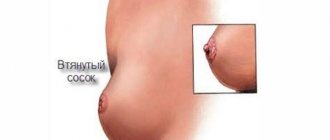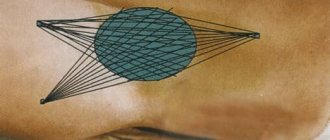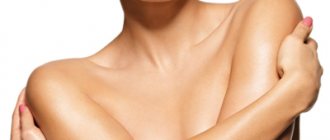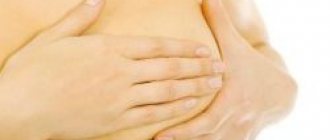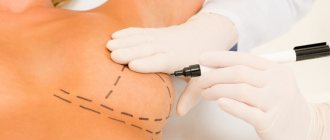There are many reasons why the color, shape or size of the nipple and areola may change. Sometimes it occurs suddenly and does not last long. You may have noticed that your nipple becomes twice or even three times its normal size during moments of sexual arousal or when you are cold. Fluctuations in the concentration of sex hormones (for example, during pregnancy) and age are also causes of completely normal changes in the nipple and areola (nipple-areolar complex).
However, if you can't figure out why your nipples have changed, it's best to tell your doctor. Remember, it's better to be safe than sorry for lost time.
Let's examine your... nipples. They can tell a lot about the health of the body as a whole. So what is considered normal, and what is better to see a doctor about.
Main types (8 options)
The classification of female nipples includes eight types. Ideally, the nipple should protrude slightly above the surface of the breast, but the options listed below are also considered normal and should not be a cause for alarm.
The most basic types are shown in the diagram above.
Protruding nipples
In this case, the nipples protrude slightly above the areola and appear slightly swollen even in a calm state. When stimulated and excited, they fill up and become denser.
Flat nipples
In a calm state, they do not stand out in any way, since they merge with the areola. They remain approximately the same during stimulation.
Puffy nipples
In this case, the areola does not look like a clear boundary - it merges with the nipple, which rises above the gland like a swollen mound.
Inverted nipples
They look recessed into the gland, but when aroused, sunken nipples can rise above the surface.
Scalene (unilateral)
The case when one nipple is retracted and the other is convex. Provided that this feature is congenital, a woman has nothing to worry about. If acquired, you need to consult a doctor as soon as possible.
Lumpy
Montgomery's tubercles - small pimples on the nipple itself and on its areola - according to some researchers, are modified sebaceous glands, the secretion of which protects the areola from drying out.
With hairs
Single dark hairs along the contour of the nipple do not add to the attractiveness of the female breast, but fit into the concept of the norm.
Their appearance may be due to a genetic factor or changes in hormonal levels. Most owners of such hairs successfully get rid of them.
Before you start fighting chest hair, you should consult a gynecologist-endocrinologist. If the doctor does not detect any pathology, the hairs can be removed.
The easiest and most accessible method is plucking with tweezers. As an alternative, you can use the waxing method.
Third nipple
This species is atypical and quite rare. This unusual nipple may look like a prominent mole, or it may be fully formed and even suitable for breastfeeding (in such cases there is a developed gland).
The third nipple occurs in both sexes. Those who are bothered by it have it removed surgically.
The second reason
The second most popular reason why the nipple halo has increased is pregnancy. During this period of life, a woman’s body can undergo radical changes - because its purpose changes. From a consumer he turns into a breadwinner. And among other changes, there are those that concern the chest. After all, after giving birth, her main function will be feeding. And for this we need to go through a series of “improvements”. So, during pregnancy, breast size can increase by an order of magnitude. In addition, nipple halos increase. They can also change their color to a darker one. And the nipple itself begins to swell and gradually increases in size. And these are not the worst changes. Often during pregnancy, small papillomas may appear on the chest, which after a while turn black and fall off. Hairs may also appear around the halos. This is due to changes in hormonal levels in pregnant women, which sometimes works real miracles for the body.
Variety of shapes and colors
Typically, nipples are round or oval in shape. But it also happens that they merge with the surrounding skin, and then it is not possible to determine the shape.
In the case of large mammary glands, it often becomes specific: there are areolas that occupy almost the entire breast.
The shape can change for various reasons:
- delayed physical development;
- prolonged wearing of incorrectly chosen underwear;
- injuries;
- dysfunction of the mammary glands.
As for color, it depends on the woman’s skin tone and individual metabolic characteristics and varies from flesh and pale pink to dark brown and even black.
It happens that the nipple has a darker shade than the areola, which is not a pathology.
Often, fair-haired girls have a light color, while dark-haired women have a darker color.
During pregnancy, nipples may darken and remain a new shade until childbirth. The same phenomenon is sometimes observed in women who are breastfeeding.
"Lump" and lump in the nipple area
Nipples are sensitive to the slightest influence - this is one of the main erogenous zones. The skin (including the nipples) has smooth muscle cells. Cold causes these cells to contract, reducing the area of skin so that the body can warm up faster. This reaction is similar to goose bumps. The nipple is pushed upward, becomes harder and more noticeable to the eye, and irregularities appear on the areola.
During pregnancy, the “pimples” on the areola (Montgomery glands) begin to swell (preparation for breastfeeding). However, if you experience a lump on your nipple or areola or a lump near your nipple when you are not pregnant, you should consult your doctor.
This may be a sign of a less serious problem: a blocked milk duct, intraductal papilloma, nipple blister, or abscess. But it can also be a sign of ductal carcinoma in situ (DCIS), a curable form of early-stage breast cancer.
To determine the cause of the formation of a lump in the nipple area, a biopsy (most often puncture aspiration) or ductography (an X-ray method with injection of a contrast agent into the ducts of the mammary gland) may be required.
Pathologies
Approximately every tenth woman reports nipple deformation. Most often, a doctor is consulted with a problem such as acquired hollowness or the location of the nipples at the same level as the areola.
Unfortunately, the pathological process associated with retraction can occur unnoticed over a fairly long period, during which the woman does not notice anything.
For many, the problem manifests itself already during pregnancy, and during lactation it becomes an obstacle to the normal feeding process. In some cases, this leads to the development of lactostasis and mastitis.
How does nipple retraction occur? The mechanism of development of the pathology is as follows: in the area of the nipple, just where the ducts of the mammary gland end and are attached, the process of replacing ordinary tissues with connective or sclerotic ones begins. The growth of fibrous tissue leads to intense tension or retraction of the nipples.
The first thing to do is to check the mammary glands for the presence of tumors, especially if pain occurs. You should be wary of lumps, fluid leaking from the nipples, scratches and crusts.
Diagnosis should be carried out by a mammologist or gynecologist. A qualified specialist will refer the woman to undergo the necessary tests (sometimes even bacterial examination of the nipples), breast ultrasound and mammography.
Pain in the nipple and areola area
Soreness to the touch, itching, or persistent nipple pain that is not related to pregnancy or the menstrual cycle should be checked.
Symptoms such as nipple pain are rare with breast cancer. However, this may be the first sign of malignancy. In addition, pain in the nipple can be bothersome due to mastitis, fibroadenoma and benign cyst.
Find out more: Why do women's nipples hurt?
Question answer
The formation of the nipple begins in the child even before birth.
Clear outlines appear only in adolescence, when the mammary glands are in the process of growth. The main role here is played by hormonal levels: it is different for everyone, so the rate of breast growth and its size are different. Any breast care procedure has a positive effect on the appearance of the nipples, regardless of their type and shape. In addition, in addition to home activities, there are modern salon procedures that are carried out by specialists and guarantee results.
This is a rare occurrence. Occurs in 0.2-5% of women.
Why do halos change size? What are the different shapes of nipples in women? Why did the nipple halo increase?
A large halo around the nipples forms for several reasons:
- This feature is often inherited. It does not appear immediately, but only after the girl’s mammary glands are fully formed. Each organism has individual characteristics. In this regard, the breasts take on their final form at different times, for some by the age of 18, for others by the age of 25. Therefore, some women may be surprised by its sudden transformation. For the same reason, large nipples are formed in men.
- While expecting a baby, the female body undergoes serious changes. Under the influence of hormones, the mammary glands are rebuilt and prepared for feeding a newborn. Enlarged nipples are completely normal during pregnancy. In addition, individual hairs may grow along the edge of the halo and pigment spots may form. This can spoil the appearance and mood of the expectant mother. But you shouldn’t be upset, after giving birth the hormonal levels will be restored, and all these symptoms will pass very quickly.
- The areola becomes very large after prolonged breastfeeding. The breasts swell greatly during milk flow and gradually stretch. Unfortunately, it is impossible to prevent this phenomenon. Young mothers can only resign themselves and wait for the end of breastfeeding to get their breasts in order.
Nipple correction (3 cases)
But is it possible to correct nipples of different types? Indeed, today it is not necessary to put up with the shape of this part of the body, since there are different ways to correct them.
Correction of nipples with hollowness
The desire of women to eliminate such a disadvantage as a sunken nipple is easy to understand: such breasts cannot be called beautiful, and if it is also non-functional (difficulty with feeding), then you need to look for a way to solve the problem.
How to enlarge a nipple? To bring it to the surface when it is sunken, they resort to a conservative or invasive method. The first is the use of special attachments and massage, the second is the operation.
There are such massage options:
- Special self-massage. This is a measure that can be resorted to with a mild degree of retraction. It is necessary to carry out daily procedures for rhythmically squeezing the nipples with your fingers, which are then supplemented with twisting elements. The latter are carried out through a gauze napkin. Massage cannot be performed after pregnancy, since such an effect on the breast provokes uterine contractions, which is extremely dangerous for the fetus in the first trimester.
- Nozzles They are used in cases where the patient is contraindicated for surgical intervention or requires preparation for it. Nozzles are attached to areas whose relief needs to be restored, and air is pumped out of them. The wearing period is several days. Due to the negative pressure in the nozzles, the connective tissues are stretched, and the nipples rise to the surface of the glands.
Surgery can also help correct sunken nipples. The success of the operation largely depends on whether the woman plans to have children, since the result depends on how deeply the tissue is affected.
With gentle intervention, the milk ducts are not affected, but the effectiveness of the operation is 80%.
A deep incision increases it to 95%, but the likelihood that a woman will be able to breastfeed is practically reduced to zero.
The postoperative period is about three days. During this time, the patient is under medical supervision and is given painkillers and anti-inflammatory drugs.
After discharge, it is necessary to abstain for some time from thermal procedures and the use of cosmetics with a greasy consistency. If there are hematomas, treat them with a special ointment. You cannot touch the operated area.
Correction for bulge
If the nipples protrude strongly, this defect can only be corrected surgically. A portion of the pigmented skin is excised and internal sutures are placed on the incisions.
You can reduce the areola in this way by 3 - 4.5 centimeters.
The operation to eliminate excessive nipple convexity is less traumatic than in the case of inverted nipples, since it does not affect the ducts and fundamental layers of the epidermis.
In this case, the patient does not need long-term rehabilitation and returns to normal life almost immediately.
With an unclear outline
To correct the unclear contour and color of the nipple area, the method of micropigmentation is used, in other words, a tattoo on the nipples.
A good technician can help in the following ways:
- optimize the shortcomings of the operation;
- minimize asymmetry;
- give the areolas greater expressiveness;
- reconstruct the nipple after mastectomy using a three-dimensional drawing that will look as realistic and natural as possible.
How to return the previous size of halos
Modern plastic surgery makes it possible to quickly and painlessly return the nipple to its previous shape. The operation will take no more than an hour and is performed under local anesthesia, without anesthesia. Before plastic surgery, you need to discuss with your doctor the desired size of the halo and the specifics of the operation. A large nipple halo can help determine how much larger your nipples are than your desired size.
Previously, such plastic surgery had one significant drawback - the inability to breastfeed in the future, since the operation damaged the milk ducts in the halo, through which milk moves from the breast to the nipple.
Now they have learned to eliminate this drawback, since during the operation only the top layer of skin is tightened, without affecting its deeper layers, in which the ducts are located. In addition, endoprosthetics provides a breast lifting effect, giving it a toned shape and elasticity.
Large nipple halos (photo below) can be reduced in diameter by 4 cm during surgery, which will allow the woman to feel confident and get rid of ridiculous complexes. The breast is completely restored in a couple of months. During this time, the seam becomes almost invisible, and the sensitivity of the nipple becomes the same.
Care and recovery (4 tips)
Caring for the mammary glands and nipples is a whole complex of daily procedures. You just have to develop the habit of spending a little time on them, and the appearance of your bust will certainly delight you with its beauty and elasticity.
Basic care points are:
- Cleansing. It is necessary to use only soft products: it is better to replace soap with a gel with nutritional ingredients, and a scrub with peeling.
- Hydration. To ensure that the skin of the breasts and nipples does not lose moisture and, accordingly, does not lose elasticity, it is important to choose the right creams. They must contain such plant components as aloe, ginseng, horsetail, hops, St. John's wort, and fenugreek. Breast cosmetics containing vitamins A, E, and C, essential oils of muscat rose, lemon and pine have a good tightening effect. It is also worth paying attention to rosehip oil, rich in vitamins and minerals - for many women it becomes a lifesaver during pregnancy and lactation.
- Balanced diet. To produce elastin and collagen, which inhibit ptosis (sagging) of tissues, you need to consume a sufficient amount of protein, amino acids, vegetable fats, and vitamins. Advice: Avoid sudden weight changes. This not only harms the condition of the internal organs, but also significantly affects the condition of the breasts and, accordingly, the nipples.
- Physical exercise. Planks, push-ups, and gymnastics for the pectoral muscles are ideal exercises for toning the chest. It is also worth monitoring correct posture: this reduces the load on the mammary glands and sagging tissue occurs much more slowly.
Carrying out the operation
Before this, the patient must be examined very carefully. After all, it is necessary to find out whether there are contraindications for anesthesia and surgery in general. The choice of type of operation depends on the characteristics of the woman.
So, if she plans to have children in the future and breastfeed them, the doctor tries to minimally affect the connective tissue. It is necessary to take into account the fact that this type of surgery is effective only in 80% of cases. However, it is considered more gentle.
If the girl has no plans for lactation, the incision is made deep, and then the positive effect of the operation occurs in 95% of cases. As a result, the woman will hardly be able to feed the child, since the milk ducts will be crossed.
Expert opinion
- Cosmetologist
- Surgeon
Michelle Ellern
practicing cosmetologist-dermatologist
With surgical correction, there is a risk of scarring and loss of sensation, since there is a high probability of damage to the nerve endings. Therefore, it is very important that a woman, when deciding to have an operation, knows about all its likely consequences and can weigh all the pros and cons.
Theda Contis
plastic surgeon
Before surgery, you should undergo a thorough examination. The fact is that it is important to identify all contraindications. It all depends on the characteristics of a particular patient. If a woman plans to breastfeed her baby in the future, then the doctor will try not to affect the connective tissues.
https://youtu.be/v_zAR3gqCgk
The beauty of a woman's breasts is largely determined by shape and color, of which there are many types. Not all of them are ideal, but today almost any defect in appearance can be corrected or minimized with the help of doctors and cosmetologists.
At the same time, it is important to weigh the pros and cons and understand that in many respects the condition of the breasts and nipples depends on the degree of intensity of care for them, as well as the woman’s lifestyle.
Unusual shape
Representatives of the fair sex often look for the shape of the nipples of a woman's breast in a photo to make sure that they do not suffer from any pathologies. The variety of shapes determines the presence of nipples that are far from standard, and this is absolutely normal. The unusual shape of this part of the body can become a highlight; this is not always a cause for concern.
Of the unusual shapes, the most common are large nipples, occupying almost the entire chest. They are usually surrounded by an equally large areola. This feature occurs in breasts of any shape, any size. The unusual shape can be teardrop-shaped, extremely convex even in a calm state. As a rule, this form of female nipple occurs on large mammary glands of a specific shape.
It should be borne in mind that if the owner is worried about this, she, if she has the funds, can pay for plastic surgery that will change the shape. As a result, the appearance of the breasts will change.
